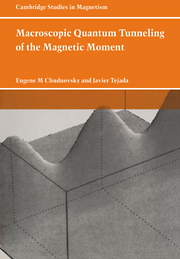Book contents
- Frontmatter
- Contents
- Preface
- Chapter I Introduction
- Chapter 2 Tunneling on a macroscopic scale
- Chapter 3 Magnetism in imaginary time
- Chapter 4 Magnetic tunneling in bulk materials
- Chapter 5 Quantum magnetic relaxation
- Chapter 6 Other experimental approaches
- Chapter 7 Tunneling in magnetic molecules
- References
- Index
Chapter 3 - Magnetism in imaginary time
Published online by Cambridge University Press: 16 October 2009
- Frontmatter
- Contents
- Preface
- Chapter I Introduction
- Chapter 2 Tunneling on a macroscopic scale
- Chapter 3 Magnetism in imaginary time
- Chapter 4 Magnetic tunneling in bulk materials
- Chapter 5 Quantum magnetic relaxation
- Chapter 6 Other experimental approaches
- Chapter 7 Tunneling in magnetic molecules
- References
- Index
Summary
An overview of the problem of spin tunneling
In this chapter we shall apply conceptions from the previous chapter to tunneling of the magnetic moment. We will begin with the problem of spin tunneling in a nanometer-size single-domain ferromagnetic particle. The particle will be considered small enough that one can treat its moment as a fixed-length vector that can only rotate as a whole. This approximation, which should be good in some but not all cases, is discussed in some detail below.
The absolute value of the magnetization in ferromagnets, M0, defined as the magnetic moment of 1 cm3 of the material, is formed by the strong exchange interaction between individual spins. This interaction has its origin in the nondiagonal (in spin) matrix elements of the Coulomb interaction between electrons of neighboring atoms. For that reason the energy, ∈ex, required to rotate one atomic spin with respect to its neighbors is of the order of 1 eV times a factor proportional to the overlap of the corresponding wave functions. A good estimate of that energy is provided by the Curie temperature. If one takes a material that is ferromagnetic at room temperature and cools it down to a few kelvins, the probability that any individual atomic spin flips with respect to other spins is proportional to exp (–∈ex/T), that is, exponentially small. For that reason, at low temperature, treating the magnetization of a bulk ferromagnet as a fixed-length vector must always be a good approximation.
- Type
- Chapter
- Information
- Macroscopic Quantum Tunneling of the Magnetic Moment , pp. 29 - 60Publisher: Cambridge University PressPrint publication year: 1998



